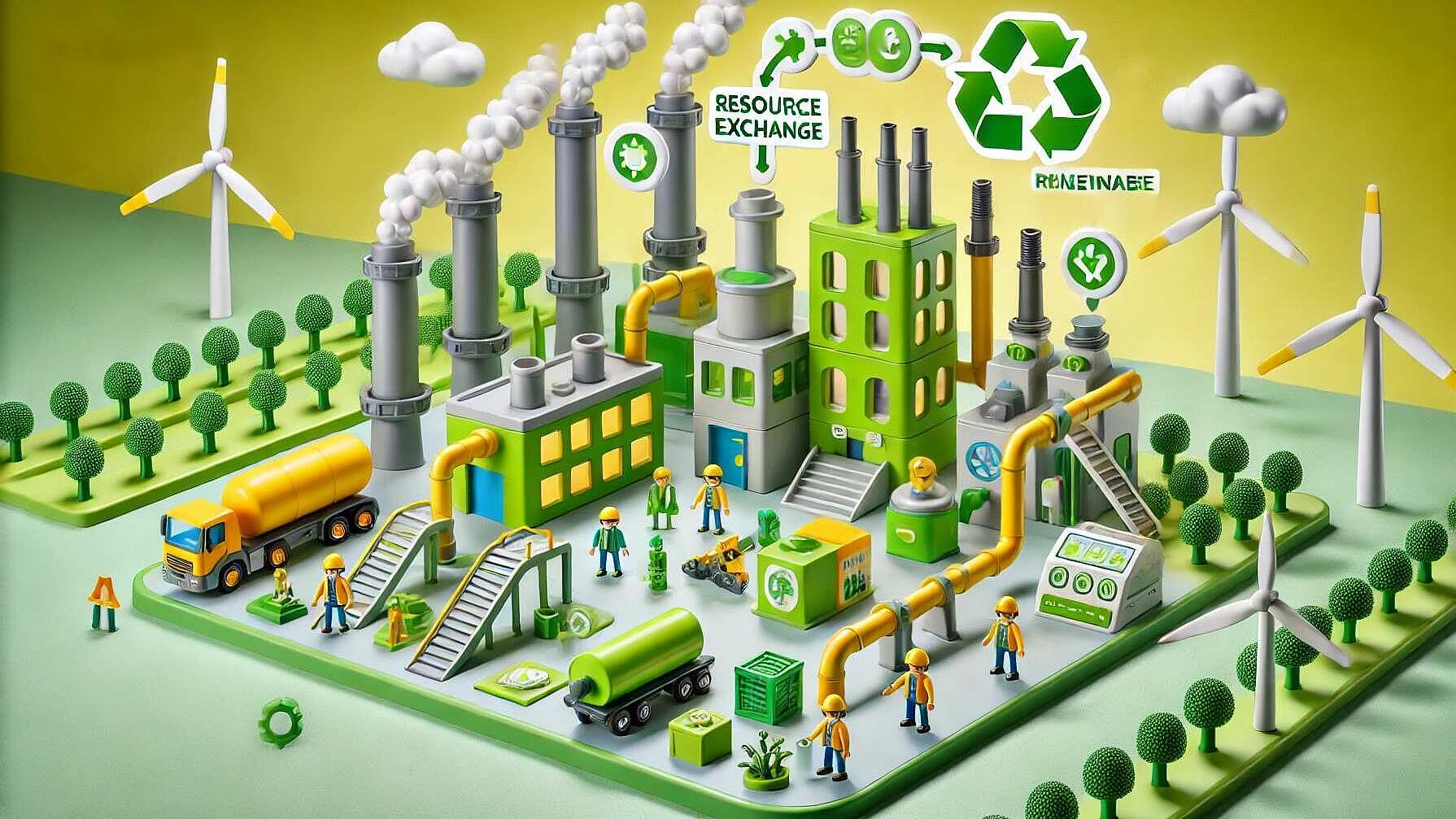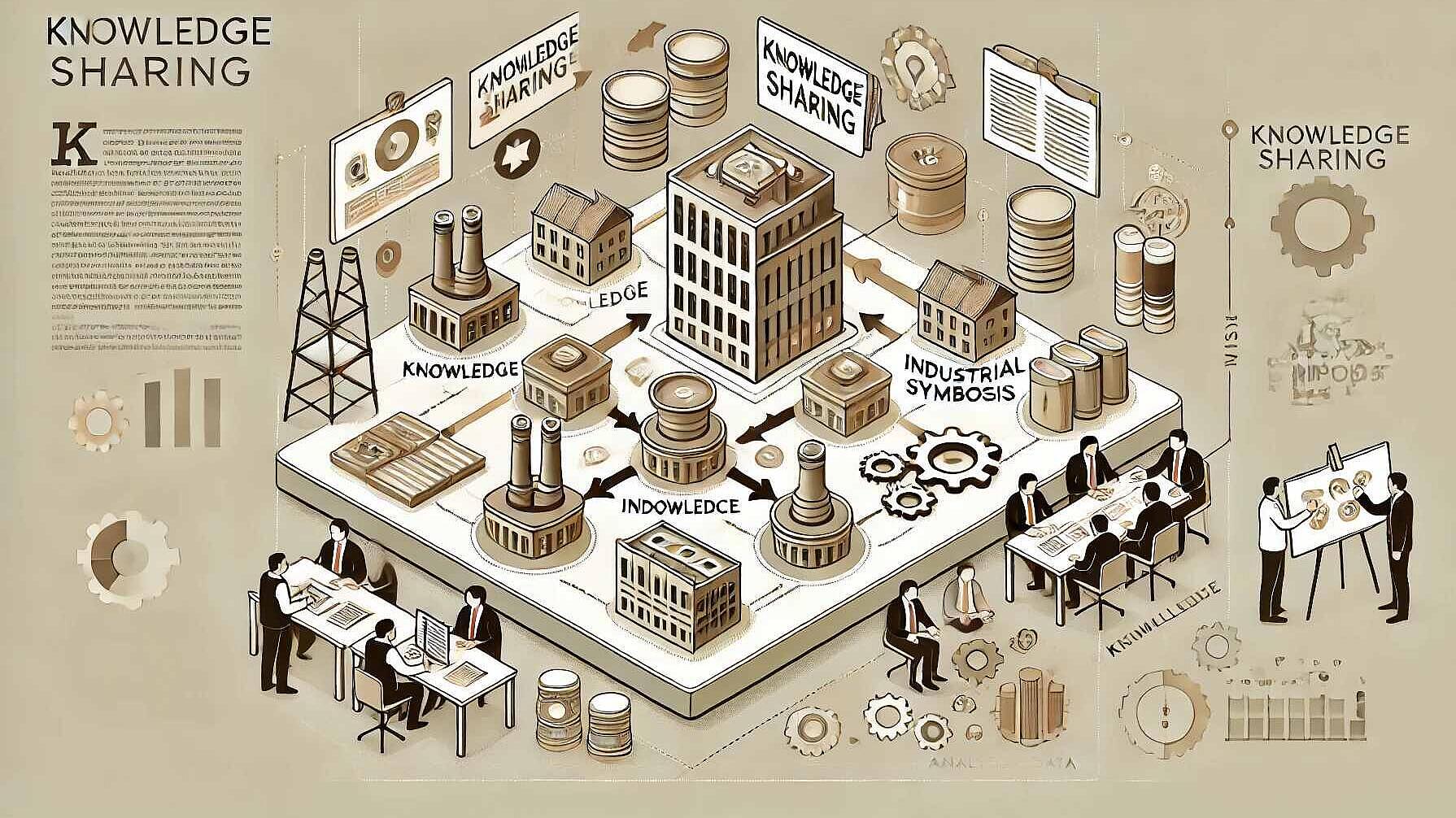 Circular Economy
Circular EconomyBusiness Value Through Industrial Symbiosis
Summary
Industrial symbiosis (IS) involves collaboration among businesses to utilize each other’s wastes or byproducts, thereby reducing environmental impact and improving economic efficiency. Despite the recognition of IS’s environmental benefits, a structured understanding of its full business value is often lacking. The business value framework developed for IS identifies four key domains of benefits and sacrifices: cost implications, revenue growth and diversification, risk management and reduction, and the intangible benefits of soft values.
Cost savings are evident in reduced procurement and logistics expenses through the use of secondary materials, but new cost challenges can arise from required infrastructure investments and compliance costs. Revenue opportunities emerge from selling byproducts and improved marketability due to eco-conscious practices, with regulatory incentives also providing financial attractiveness. IS strategies can reduce supply chain and market risks, although they may introduce dependencies and require quality control investments. Soft values encompass enhanced innovation, stakeholder relationships, brand reputation, and employee engagement.
As global movements towards sustainability and circular economies advance, IS is gaining relevance, with technological and policy developments further facilitating its adoption. For businesses, taking a strategic approach that includes identifying synergy opportunities, forming partnerships, investing in technology, navigating regulatory landscapes, and communicating value propositions is essential for harnessing the competitive advantages offered by IS.
Open full article
Business Value Through Industrial Symbiosis
The following article is a summary of the report “A Business Value Framework for Industrial Symbiosis” delivered by the EU project CORALIS. And it is also a training article for the Enerwhizz, which is a fast-paced quiz on energy transition, greentec and renewables. Answer 5 YES-No questions in 45 seconds to earn cash coins and win prices delivered to your office or home. No registration, just play!
Check: https://enerwhizz.app/
Industrial symbiosis (IS) is revolutionizing resource management and sustainability across industries. By fostering collaboration among businesses to optimize resource use, IS reduces waste, enhances efficiency, and generates economic and environmental benefits. However, despite its growing prominence, the understanding of IS’s full business value remains fragmented. A newly developed business value framework sheds light on the tangible and intangible advantages of IS, offering a structured approach to evaluating its benefits.
The Current Landscape of Industrial Symbiosis
Industrial symbiosis operates on the principle of inter-firm collaboration, where one company's waste or byproduct becomes another’s raw material. This model reduces environmental impact while enhancing economic efficiency. Examples of IS range from waste heat recovery in manufacturing plants to the repurposing of chemical byproducts. Notably, eco-industrial parks worldwide have demonstrated how IS fosters sustainability while maintaining economic viability.
While IS is recognized for its environmental contributions, its business value is often underappreciated. Companies engaging in IS can experience cost savings, revenue growth, risk mitigation, and enhanced intangible benefits. However, without a structured understanding of these values, businesses may struggle to maximize the potential of IS collaborations.
Unpacking the Business Value Framework
A comprehensive business value framework for IS categorizes benefits and sacrifices into four key domains: costs, revenues, risks, and soft values. By systematically evaluating these factors, businesses can better assess the feasibility and long-term impact of IS initiatives.
1. Cost Implications
One of the most immediate advantages of IS is cost reduction. Businesses can lower procurement costs by sourcing secondary materials from symbiotic partners rather than purchasing new raw materials. Logistics and transportation expenses may also decrease if IS collaborations occur within close proximity, minimizing supply chain distances.
However, IS can introduce new cost challenges. Investment in infrastructure, such as specialized equipment or transport networks, may be necessary. Additionally, administrative and compliance costs may rise due to new regulatory requirements or the need for permits. Despite these potential increases, the overall financial benefits of IS often outweigh the initial expenditures, particularly when companies capitalize on shared infrastructure and collaborative innovation.
2. Revenue Growth and Diversification
IS provides businesses with new revenue streams. Companies can generate income by selling byproducts that were previously considered waste. Additionally, improved environmental performance can enhance the marketability of products, allowing firms to charge premium prices or expand their customer base.
For instance, firms engaging in IS have successfully monetized secondary materials, such as repurposed chemicals or energy byproducts. In some cases, regulatory incentives and government grants further bolster revenue opportunities, making IS a financially attractive model for businesses looking to innovate and expand.
3. Risk Management and Reduction
Risk management is a crucial aspect of business strategy, and IS can play a significant role in mitigating uncertainties. Supply chain risks are minimized when companies secure a steady stream of secondary materials from industrial partners. Moreover, long-term contractual agreements between IS participants help stabilize pricing and reduce exposure to market fluctuations.
Conversely, IS can introduce dependency risks. If a key IS partner faces operational disruptions, it may impact the entire network. Quality fluctuations in secondary materials can also pose challenges, requiring investment in quality control mechanisms. Despite these risks, businesses that implement robust IS governance structures can navigate uncertainties effectively and build more resilient supply chains.
4. The Intangible Benefits of Soft Values
Beyond direct financial gains, IS contributes to significant intangible benefits, often categorized as soft values. Knowledge-sharing among IS partners fosters innovation, leading to improved operational efficiencies and the development of new technologies. Businesses engaged in IS often experience enhanced stakeholder relationships, including stronger community ties and improved regulatory goodwill.
Strategically, IS aligns with corporate sustainability goals, reinforcing brand reputation and investor confidence. Companies that demonstrate leadership in sustainability through IS initiatives gain competitive advantages, attracting environmentally conscious customers and partners. Additionally, IS can enhance employee engagement, as staff take pride in contributing to a sustainable business model.
The Future of Industrial Symbiosis
As industries increasingly prioritize sustainability, the relevance of IS will continue to grow. The transition toward circular economies—where waste is minimized, and resources are continually repurposed—will further propel IS adoption across sectors. Technological advancements in waste processing, digital tracking of resource flows, and AI-driven analytics will enhance IS efficiency and scalability.
Moreover, policy frameworks are evolving to support IS adoption. Governments and regulatory bodies are introducing incentives for circular business models, creating an enabling environment for IS collaborations. Businesses that proactively integrate IS into their strategies will be well-positioned to leverage these policy shifts for competitive advantage.
Embracing Industrial Symbiosis for Competitive Advantage
For businesses seeking long-term sustainability and profitability, IS presents a compelling opportunity. To maximize its potential, companies should:
- Identify Synergy Opportunities: Assess waste streams and byproducts that could serve as inputs for other industries.
- Engage in Strategic Partnerships: Establish collaborations with industrial counterparts to develop symbiotic relationships.
- Invest in Enabling Technologies: Leverage digital tools to track, optimize, and streamline resource flows.
- Navigate Regulatory Landscapes: Stay informed on policy incentives and compliance requirements to maximize IS benefits.
- Communicate Value Propositions: Showcase IS contributions to sustainability and economic growth to attract investors and partners.
Conclusion
Industrial symbiosis is reshaping the way businesses manage resources, offering a pathway to economic efficiency and environmental sustainability. By leveraging the business value framework, companies can systematically assess the benefits and challenges of IS initiatives. As industries transition toward circular economy models, IS will play an integral role in driving innovation, reducing waste, and fostering collaborative growth. Embracing IS is not just a sustainability imperative—it is a strategic advantage for forward-thinking businesses poised for long-term success.
If you read the full article, you are perfectly equipped to play and win. And to have fun with friends leagues, leaderboards, missions and whizzers. And likely in your language as we are supporting 12 languages.
And if you found nuggets you want to have a deeper look at – check the source document, the report “A Business Value Framework for Industrial Symbiosis” delivered by the EU project CORALIS.



